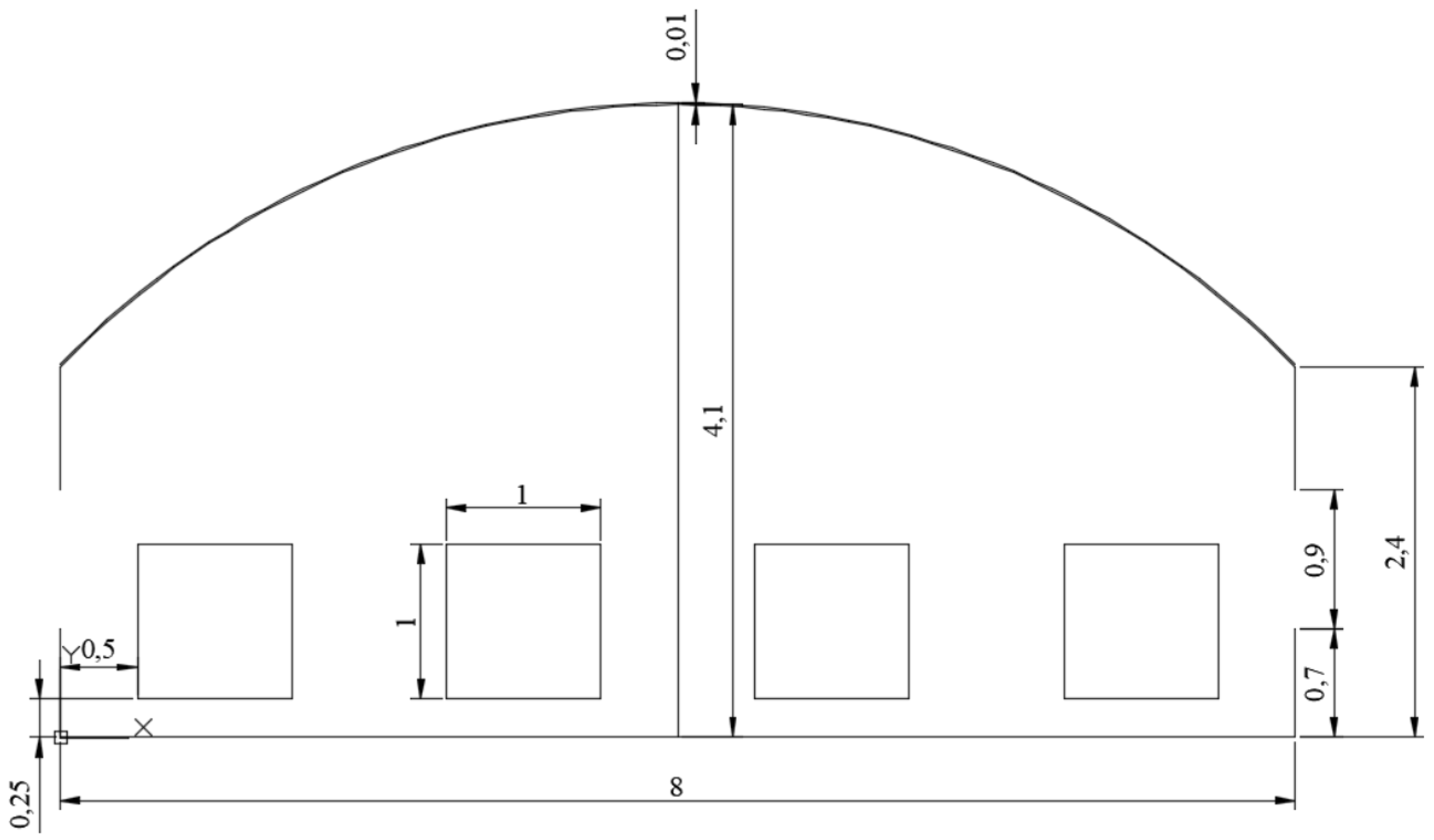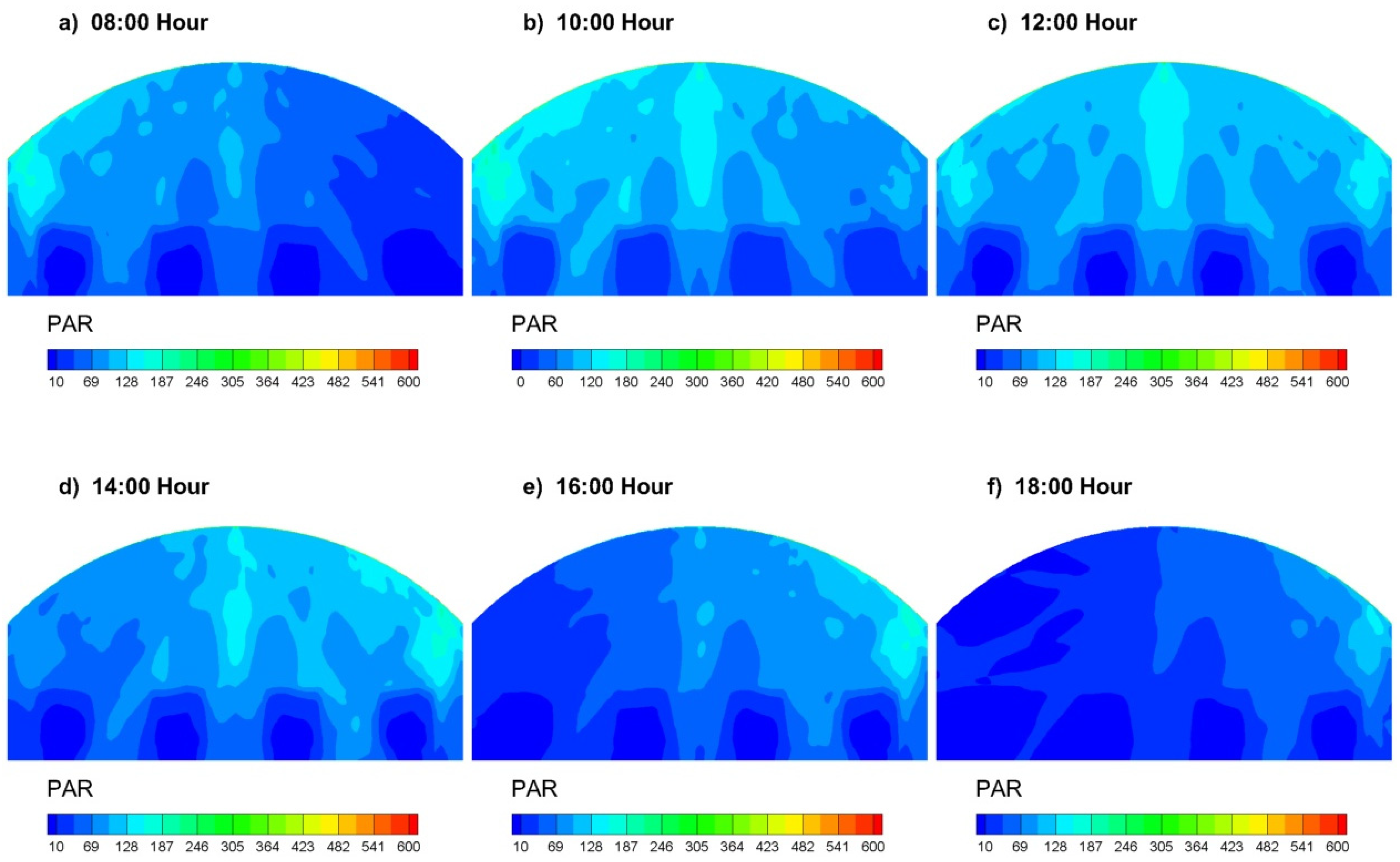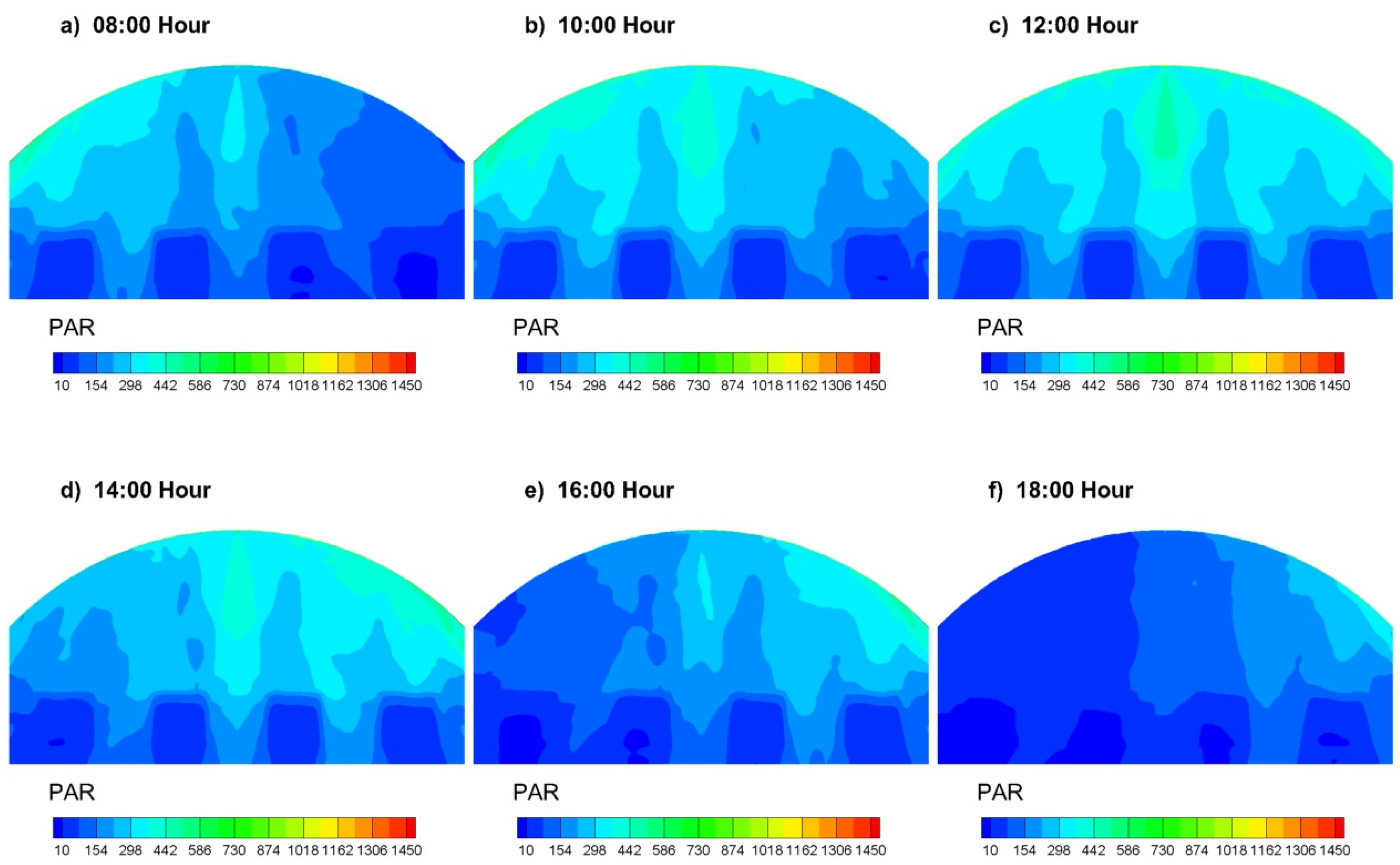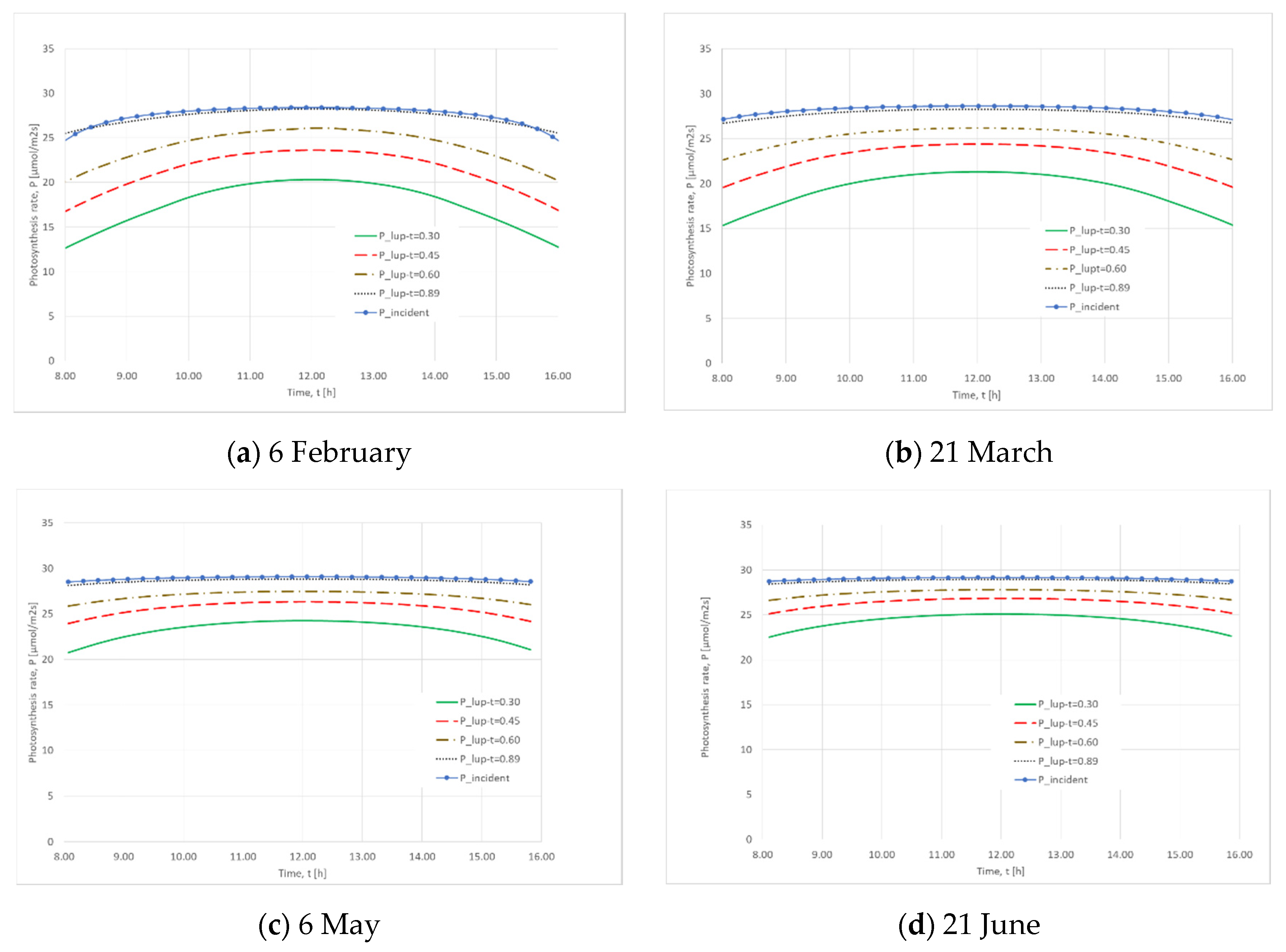3.2. Average PAR at Plant Level
The daily evolution of the average PAR values at a horizontal level 10 cm above the crop is given in
Figure 7a–h for eight indicative days of the year. Five lines are given in each graph, corresponding to (i) τ
n,PAR = 30% (green line continuous), (ii) τ
n,PAR = 45% (red dashed line), (iii) τ
n,PAR = 60% (brown dot-dashed line), (iv) τ
n,PAR = 89%—bare cover (black dotted line), and (v) PAR incident to a horizontal surface in open field (blue continuous line with blue circles).
It can be seen that for the region of Thessaly in Central Greece (the region of the case studies considered) the outside incident PAR had a maximum value of about 125 W m−2 during 21 December (date with the lowest radiation level among the dates studied) and of about 340 W m−2 during 21 June (date with the highest radiation level among the dates studied). The corresponding values for the case of the greenhouse covered with a bare PE film are 100 W m−2 and 270 W m−2, respectively.
The daily PAR solar energy at plant level for the examined days and for the examined cover/PV combinations is given in
Table 9. The values given in parenthesis correspond to the daily average greenhouse transmission to PAR.
The most commonly grown species in greenhouses are vegetables with medium thermal requirements (tomato, pepper, cucumber, melon, watermelon, marrow, green bean, eggplant); the aim is to extend the growing calendars beyond the conventional open-air cultivation season, and thus increase profitability. Tomato cultivation requires high solar radiation levels, but there are other crops that do not need so much sunlight for proper growth. PAR light may not be considered as a limiting growth factor for a tomato crop at levels greater than 200 W m
−2. Of course, optimal light levels are difficult to define since the crop productivity is also related to many other parameters like air temperature, relative humidity, and CO
2 concentration [
29]. Considering the above threshold for solar radiation and taking into account the results presented in
Figure 7, it can be seen that the PAR levels inside the PE-covered greenhouse without integrated OVPs were higher than the above radiation level for a long part of the day from April to September, while for the other months studied, the radiation levels were lower than 200 Wm
−2. In addition, in all the case studies with different OPV/PE combinations, the PAR levels estimated are lower than 200 W m
−2.
Nevertheless, since it is not only the intensity of radiation but also the duration of the lighting period that plays a significant role, the solar radiation integral value will have to be taken into account. Furthermore, the fraction of diffuse to total light plays a significant role, since higher diffuse ratios result in higher radiation use efficiency. The minimum levels of the daily total solar radiation integral requirements of the above species are estimated at around 8.5 MJ m
−2 d
−1 (which is equivalent to about 4.05 MJ m
−2 d
−1 of PAR) [
30]).
The reduction observed to the mean daily PAR radiation integral (
Table 9) due to the presence of the OPVs for the cases with normal PAR transmittance of 30%, 45%, and 60% in relation to the bare PE was 77%, 66%, and 52%, respectively. Considering the threshold of 4 MJ m
−2 d
−1 and the results presented in
Table 9, it can be seen that only the case of the OPV/PE combination that results in normal τ
n,PAR of 60% can satisfy this threshold for the period between May to September. The rest of the OPV/PE combinations result in a daily PAR radiation integral lower than this threshold all year round.
Another important finding presented in
Table 9 is that although the daily average greenhouse transmission to PAR simulated for the case of the PE-covered greenhouse without integrated OVPs (87%) was close to the normal PAR transmission value given for this case (89%). The simulated values estimated for the other cases were significantly lower than the normal PAR transmission of each case. More specifically, the daily average greenhouse transmission to PAR simulated for the cases of combinations OPV/cover that correspond to normal transmittance in the PAR spectrum equal to 30%, 45%, and 60% were 19%, 29%, and 41%, respectively. The respective difference between the normal PAR transmission and the simulated daily average greenhouse transmission to PAR for the cases of OPV/cover combinations with normal PAR transmittance of 30%, 45%, 60%, and 89% were 36%, 35%, 31%, and 6%, respectively. This nonlinearity is due, on the one hand, to the logarithmic relation that links transmissivity to the extinction coefficient and to the light path length [
20] and, on the other hand, to the fact that the average equivalent transmissivity is the result of reflections within the interior of the greenhouse. The above difference was lower during the period from September to December for almost all the OPVs/PE combinations studied. This is in agreement with the measurements presented by [
8] who showed that the lowest difference was found in December, and it increased during the rest of the year until reaching the maximum in June and July. In practice, the overall greenhouse transmissivity is lower than the normal transmission value declared for the cover material due to factors such as shading of the structural elements of the roof, dust, and the angle of incidence of the sunrays, which is always different from the perpendicular rays used by manufacturers to test the transmissivity of their materials [
31,
32]. In addition, the results presented in [
8], which studied the propagation of solar radiation in a greenhouse with south-oriented photovoltaic roofs, showed that the solar radiation measured below the photovoltaic roof consists only of diffuse radiation.
3.3. Average Photosynthesis Rate at Plant Level
In the same way,
Figure 8a–h presents the evolution of average photosynthesis rate in a line 10 cm above the plants during the day, for eight indicative days of the year. Again, in each graph, five lines are given corresponding to (i) τ
n,PAR = 30% (green line continuous), (ii) τ
n,PAR = 45% (red dashed line), (iii) τ
n,PAR = 60% (brown dot-dashed line), (iv) τ
n,PAR = 89%—bare cover (black dotted line), and (v) photosynthesis rate in open field (blue continuous line with blue circles). It should be noted that in the current simulation the side walls are considered opaque and the radiation enters the domain only through the arched roof.
The daily photosynthesis rate at the plant level is given for the examined days and for the examined cover/PV combinations is given in
Table 10.
The year-round mean values of the daily average photosynthesis rate simulated for the cases of OPV/cover combinations with normal PAR transmission of 30%, 45%, 60%, and 89% were 18.1, 21.3, 23.7, and 27.1, respectively. Based on the above findings, it could be seen that the reduction observed in the mean daily average photosynthesis rate (
Table 10) due to the presence of the OPVs for the cases with normal PAR transmittance of 30%, 45%, and 60% in relation to the bare PE was 33%, 21%, and 12%, respectively. Similar results were also observed in the reduction of the cumulative daily photosynthesis rate.
The results of a literature survey [
33] showed that a 1% radiation reduction results in a 0.6% to 1.1% yield reduction in tomato crop, whereas interviews held with growers indicated values between 0.7% and 1.0%. It is difficult to survey the growth and yield reduction. Shading of a crop at high light intensities only slightly reduces photosynthesis of the upper leaves in the light saturation range. On the other hand, shading at low light intensities may change the net photosynthesis from positive to negative values, especially for the lower leaves. Accordingly, it could be also stated that photosynthesis is significantly affected by shading mainly in regions or periods with low radiation levels.
Kläring and Krumbein (2013) [
34] studied the response of tomato to constraining the intensity of solar radiation. They found that although they reduced the PAR radiation by 57% and 34%, the measured plant dry matter increment decreased only by 31% and 19%, respectively, that is, light use efficiency increased markedly. This indicates a strong adaptation of the plant’s metabolism to cope with the limitation in light availability such as increasing the specific leaf area and reducing respiration.
Excessive solar reduction caused by high shading rates can decrease the total and marketable yield of tomato grown in a greenhouse [
35]. In contrast, light to moderate shading does not affect total and marketable yield [
36,
37] and can even improve production under warm growing conditions and high solar radiation [
35,
38].
Aroca-Delgado et al. (2019) [
39] found no differences in the total or cumulative marketable yield associated with the use of shading of 9.8% by photovoltaic panels.
There are other crops that do not need so much sunlight for proper growth. Examples of this, and their interaction with semitransparent PV solar panels on the greenhouse roofs, have been described in [
40]. In addition [
41], in strawberry and raspberry cultivation, concluded that the parameters of fruit quality (sugars, anthocyanins, phenols, organic acids, etc.) are not affected by the shading of solar panels on the greenhouse roof. Moreover, tests with PV panels on the greenhouse roof (20%) in pepper cultivation have been described in [
42]. These authors concluded that the quality of the pepper fruit is not affected.
3.4. Power Production
Two challenges are faced when calculating the power production from OPV panels incorporated in an arched greenhouse. The first challenge concerns the arched section geometry since each point of a section of the roof has a different inclination angle. Consequently, the energy production of the entire panel surface will be determined by the cell with the worst inclination depending on the internal inter-connection. This challenge was treated with the choice of narrow OPV panels (0.15 × 0.82 m) arranged along the main greenhouse axis in such a way that each panel traversed only 0.15 m across the cross-section. In this way the inclination angles of the beginning and the end differ only by 1.54° allowing us to consider for each panel an average inclination angle. The OPV electrical characteristics are Voc = 6 V, Isc = 1 A, Vmp = 4.3 V, Imp = 0.9 A.
The second challenge concerns the choice of inverter due to the low V
mp and power which prevents them to collaborate with the majority of existing inverters who have a voltage threshold in the order of 250 V or higher. This challenge was treated with the choice of a mini inverter with power threshold 3 W and minimum MPP voltage 28 V, considering appropriate panel interconnection. This way, the yearly power production from the OPV in the greenhouse roof per greenhouse meter was calculated for the whole section and is presented in
Table 11 for the three examined cases. For the calculation, the overall temperature coefficient was considered 0.02%/°C [
12]. In the same table, the primary energy and CO
2 saving offered by the PV are presented considering that electrical power is replaced.
Nevertheless, the design of a PV system incorporated in an arched greenhouse in terms of its environmental footprint depends on many factors, including the type of the crop, the greenhouse operating strategy, and the size of the greenhouse, which affect the yearly power demand profile and the available roof area.
















